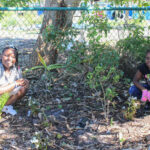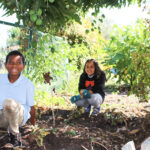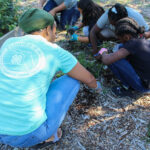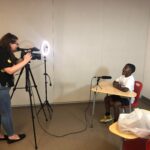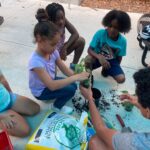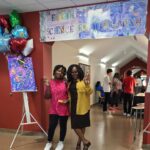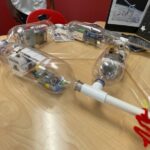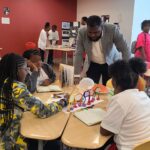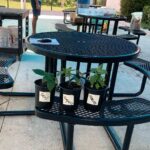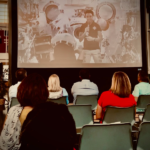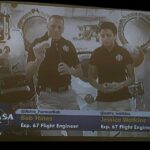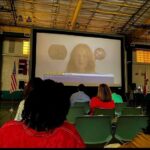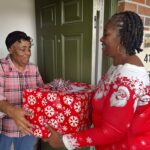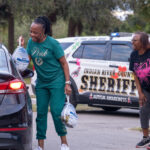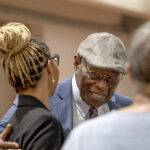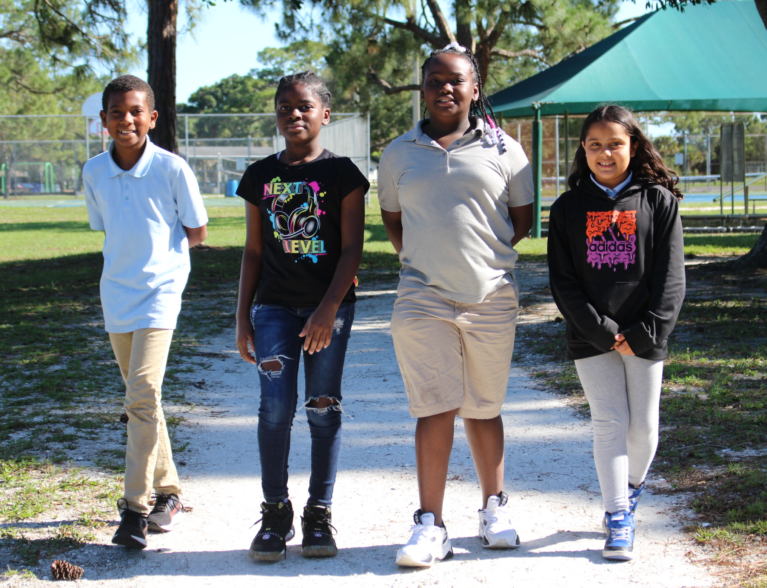
GIFFORD — What’s the difference between plants that grow on the Earth and those that sprout to life in space?
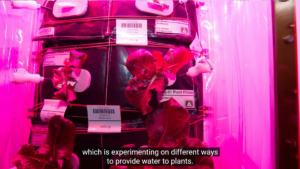
Astronauts aboard the space station are experimenting different ways to provide water to plants. PHOTO PROVIDED BY NASA DOWNLINK
That’s one of many questions astronauts aboard the International Space Station – floating more than 250 miles above the planet – are using experiments to find out.
But on Earth, as it is in the skies above, it is also a question Leslie Nicole Munroe ponders as she teaches fourth-grade students at the Gifford Youth Achievement Center how to grow plants on the ground.
Munroe, a gardening instructor at the center, said studying plants that might grow in space will help humans understand how Earth’s environment affects plants’ growth.
“The significant difference is gravity, though it is not the only factor. Indeed, there will be noticeable differences in how plant systems function without it,” Munroe said.
“These changes become encoded in the plant’s DNA so the next generation can survive the condition. More clues about how plants react to a lack of gravity will help us learn how to enhance or mitigate how it influences plant development here on Earth.”
Over the last year, Gifford Youth Achievement Center students have immersed themselves with STEM-related projects, running their fingers through different soils, building models of the space station.
Last July, the students even talked to astronauts in a special live-stream from space. All of the experiences have helped students learn about the science of plant life.
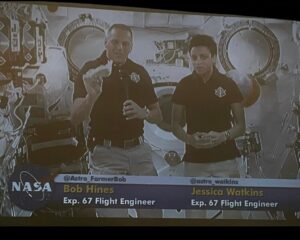
NASA Astronauts Bob Hines and Jessica Watkins answer pre-recorded questions from GYAC students via livestream from the International Space Station July 6, 2022. PHOTO PROVIDED
For astronauts, the science of how space-grown plants adapt to gravity-free environments is important in learning if changes are passed onto future generations of crops, NASA officials say. That research could help scientists learn whether similar experiments can be carried over to other real-life missions to the moon and even Mars.
Astronauts have grown radishes, chili peppers and cotton tissue cultures in space, according to Austin Jordan, vice-president of marketing and communications at Redwire Space, an aerospace agency based in Jacksonville. Solar arrays help power the space station by converting solar energy to electricity.
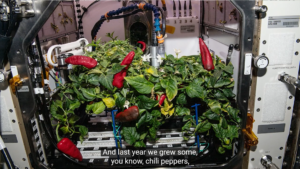
Astronauts have grown chili peppers, lettuce and radishes on the space station. PHOTO PROVIDED BY NASA DOWNLINK
Jordan, a graduate of the Science Institute of Discovery program based at the Gifford Youth Achievement Center, hopes the missions will inspire youth and others about spaceflight and STEM.
“Redwire is continuing to advance capabilities in low-earth orbit to support human spaceflight and deliver scientific insights that could deliver important benefits on earth like crop production and materials science research,” Jordan said.
Earlier this month, SpaceX launched epigenetic plant biology investigations as part of its 28th commercial resupply services mission to the space station.
Astronauts aboard the space station become space gardeners as they conduct the experiments using NASA’s Advanced Plant Habitat, an automated plant growth facility managed by Redwire. The experiments allow astronauts to keep and grow fresh crops for long-term space missions.
Seeds from the space-grown plants will be sent to Earth, and later returned to the space station so researchers can directly compare the half-ground grown control seeds and the half spaceflight-grown seeds, Redwire officials said.
“The investigation will create a second generation of plants using seeds previously produced in space and returned to Earth. Results could provide insight into how to grow multiple generations of plants to provide food and other services on future space missions,” NASA officials said in a statement.
“This investigation also could support development of strategies for adapting crops and other economically important plants to marginal and reclaimed habitats on Earth.”
“How do plants grow in space?”
NASA’s 28th CRS, or commercial resupply services mission, delivered new science experiments, food, supplies, equipment and the next pair of solar arrays to the space station last week. Last summer, Gifford Youth Achievement Center students got a glimpse of plant experiments already being conducted on the station during a NASA Downlink.
.@SpaceX launches its 28th CRS mission to the International Space Station Monday from Cape Canaveral. #VeroNews pic.twitter.com/c8YpGow3Lv
— Nicholas Samuel (@JournalistNickS) June 5, 2023
The downlink allowed 15 youth – elementary, middle and high schoolers – to have their pre-recorded questions answered live from space by Astronauts Bob Hines and Jessica Watkins, who served as flight engineers during NASA’s Expedition 67. The students asked the space explorers what type of food astronauts eat in space, how food is delivered to the space station and how plants grow in space, among other questions.
Short version of NASA Downlink with GYAC. Video provided by NASA
“How do plants grow in space?” Student Adrianna Cortes asked on video as several hundred students and county officials watched the livestream on a big screen inside the center’s gymnasium.
Hines said astronauts at the station were working on an experiment called XROOTS, which investigates different ways to provide water to plants. NASA officials showed a picture of the space plants – which grew chili peppers, lettuce and radishes – during the live Q&A broadcasted on NASA TV.
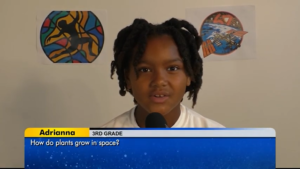
GYAC student Adrianna Cortes speaks with astronauts in space via livestream video July 6, 2022. PHOTO PROVIDED BY NASA DOWNLINK
“As you know, there’s no gravity in space. So you can’t just pour water on the plants,” Hines told Cortes. “We’ve learned that plants don’t necessarily need gravity to know which way to grow, but they do grow their roots toward the water supply.”
Growing plants is essential to not only providing food, but producing oxygen, Hines told Cortes. Plants will play a crucial role for astronauts as NASA gets closer to the Artemis II moon mission in 2024, and eventually the mission to Mars.
Gifford Youth Achievement Center students also hosted a science fair in conjunction with the downlink. The youth created models of the solar system, grew plants in different soils and fertilizers, produced concrete using different materials, built a hydroponic system and constructed a solar panel.
Faz Zaidi, a volunteer for the center, spoke about his experience helping students with the projects in a NASA survey taken after the downlink event.
“Each group worked diligently to complete their project, while also having fun along the way,” Zaidi said in the survey. “The students showed enthusiasm for the areas they were learning about, and based on their feedback they had a blast learning about space.”
Zaidi also helps instruct a robotics and coding class at the afterschool center, where students work together in teams to design, build and code their own robots. The robotics and coding class, along with a STEAM class and the Science Institute of Discovery, are being held at the Gifford Youth Achievement Center this summer.
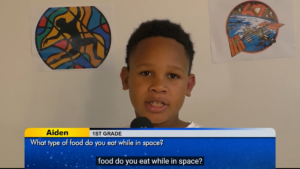
GYAC student Aiden Robinson speaks with astronauts in space via livestream video July 6, 2022. PHOTO PROVIDED BY NASA DOWNLINK
Student Aiden Robinson, who asked the astronauts what type of food they eat in space, reflected on his experience being part of the live Q&A.
“My favorite part of the downlink was seeing the astronauts live and being able to participate in the event,” Robinson said.
More information on the Gifford Youth Achievement Center can be found on its website.
Full version of NASA Downlink with GYAC. Video provided by NASA
Photos provided
- GYAC gardening students
- GYAC gardening students
- GYAC gardening students
- GYAC student Chancellor Braceley being filmed for the Q&A with astronauts in space. Photo taken in Spring 2022
- GYAC students preparing for the science fair in conjunction with the NASA Downlink. Photo taken in Summer 2022
- GYAC Science Fair held in conjunction with NASA Downlink. Photo taken in Summer 2022
- GYAC Science Fair held in conjunction with NASA Downlink. Photo taken in Summer 2022
- GYAC Science Fair held in conjunction with NASA Downlink. Photo taken in Summer 2022
- GYAC Science Fair held in conjunction with NASA Downlink. Photo taken in Summer 2022
- GYAC Downlink showcase. Photo taken in Summer 2022
- GYAC Downlink showcase. Photo taken in Summer 2022
- GYAC Downlink showcase. Photo taken in Summer 2022

